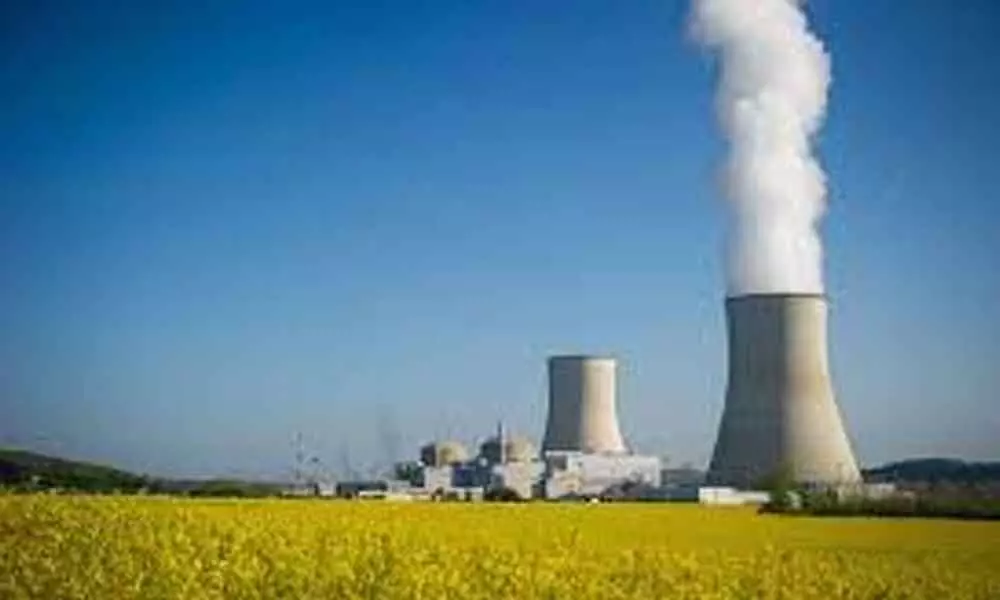Atom's energy can keep the world powered and the Nature calm

Representational Image
Humanity would never wish to face calamities, at the same time it won't choose to live in darkness either. But, I am afraid we are well on our way to one of these.
Humanity would never wish to face calamities, at the same time it won't choose to live in darkness either. But, I am afraid we are well on our way to one of these.
When Thomas Alva Edison launched the world's first public electricity generation unit in 1882 he would not have thought that he was actually setting a stage for transforming the planet into a most modern one. Nearly 14 decades after, today, human life on earth is so much interlaced with electricity. We need it for everything: for light, for commutation, for communication, for cooking, for comfort, and for several other things. Eventually, consumption of electricity has soared substantially ever since humanity began to enjoy its fruits.
With myriad number of electricity plants that have mushroomed all across the world, the present global power generation capacity has manifolded to over 25,000 Terra Watt hour. According to the Washington Post, in 2012 itself over 62000 power plants were in service in this universe. In an average, the 7.7 billion people on earth consume a whooping 300 billion units (KWh) in just a day. But still hunger for energy is mounting rapidly. And to meet this ever growing energy demand countries are building more and more power plants.
The same electricity which revolutionized the world is leading us to catastrophe now. Electricity which is often synonymised with light and brightness is presently paralleled with global warming and climate change. Electricity is not a problem as such but the way it is produced is actually. Among several methods, burning fossil fuels like coal, oil and gas is the dominant way in the energy world. Even the first public power plant "Edison Electric Light Station" was a coal-fired unit. Supposedly, thermal power plant was considered as easiest technology and it was believed that the world had plenty of fossil fuel.
How long the fossil fuels can last?
Globally, reliance on fossil fuels is on the rise. Worldwide countries are set out for rigorous reserves-hunt in their soils for fresh resources. It may, perhaps, turn out futile as much of the remains of organisms with high carbon and hydrogen content in the earth's crust have already been exploited. Then, how long the existing resources can last? If we continue to consume fossil fuels at current rate, all forms of it will run out in another 150 years. Oil deposits can last for about 50 years, gas reserves can run for about 50 years, while coal can be there for 150 years. After 50 years from today when both oil and gas reserves get over, usage of coal will go extremely high. As a result, the coal's availability will diminish drastically. And if the rate of consumption goes high then the supply of fossil fuels will come to an end sooner.
Will the problem be over if we find out more resources of fossil fuels somehow? Not really. It is not the non-availability of resources that upsets us, but the emission of greenhouse gases like carbon dioxide from fossil fuel fired power stations is. These gases harm the earth and its environment.
Are we going to face natural disasters?
Yes. Experts warn catastrophic natural calamities are waiting to happen. It is likely that such disasters may strike more frequently with greater intensity.
An alarming finding – based on several decades of observation of climate conditions – was made public by climate scientists that the earth is getting warmer day by day due to the increase in the average air temperature. Today's atmospheric temperature is about 1.3o Fahrenheit higher than what it was a century ago. And in the next 200 years it may go up even further.
Rise in the levels of green house gases like carbon dioxide, methane and nitrous oxide in the atmosphere is blamed for this changing climate. Carbon dioxide, which is largely emitted during combustion of fossil fuels, is predominant among all the heat-trapping gases. Actually, it remains there in the ambiance for over hundred years. And much of the green house gases are the emissions of power plants that use fossil fuels. Last year alone the world fossil fuel fired power plants have emitted about 37 billion tonnes of carbon dioxide. But, little did we think about the impact of too much usage of fossil fuel.
The Intergovernmental Panel on Climate Change (IPCC) in its recent report suggests that the emissions of carbon dioxide are required to be cutback radically to keep the global temperature within a 1.5 degree Celsius target. The report urges world countries to curb emissions at a best rate to attain zero emission by 2050.
Nature has already began to lose its patience, and the world is encountering some of the worst effects of global warming: Melting of ice in Polar Regions, rise of sea level at faster rate, coastal flooding, heat waves, severe droughts, increased wildfires, destructive hurricanes, growing health impacts, and several more. Also, the warming earth is causing severe stress on the ecosystem. Habitat loss and species disappearance are already underway, that to at a rapid manner. As a result of extreme natural events several individual organisms are heading for extinction and the population of many species is dwindling. Bumble bees, insects, whales, sharks, Asian elephants, giraffes and oceanic birds are at high risk.
Humans too are bearing the brunt. IPCC made a shocking revelation that 1.4 billion people across the world are at danger due to the changing climate. Rising sea level is a greatest threat of our times: The sea level which rose to at least 15 cm higher during the 20th century is rising by 3 cm every year, and perhaps in another hundred years it may reach a meter high. Anjal Prakash, a lead author of the IPCC, warns that Indian islands like Andaman and Nicobar and Maldives will become uninhabitable due to this rising sea level. According to the World Health Organisation 2014 estimate, about 2.5 lakh additional deaths could occur every year between 2030 and 2050 due to heat stress, malnutrition and malaria.
If the emissions are not curtailed in a shortest possible time, the nature can react any way and we can expect even more disastrous events. The sooner we act the better the world can be. In a recent statement, Secretary General of the United Nations Antonio Guterres said "For the first time, there is a serious conflict between people and nature, between people and the planet." He also urged world countries not to bring new coal power plants after 2020 and cut back the carbon emissions by 45 percent in the next century.
Then, do we have to live in darkness?
Today thermal power plants across the world account for over 60 percent of global electricity production. What will happen if we do away with fossil fuel based power plants totally? Whether we need to live in darkness like we did centuries ago? Or, will we have to live with intermittent power supply?
Switching to carbon-free electricity is the only solution to this humanity's greatest challenge. But, where will such an enormous amount of clean electricity come from? There is a popular belief that wind and solar which are abundant in nature alone can deal this. But reality is far from it, renewable being intermittent source can't be of great help without the support of a base load source like coal or nuclear.
Nuclear has none of the problems that fossil fuel and renewables have: it can produce electricity non-stop all round the year without harming the environment. According to the feature "Nuclear power can save the world" published in The New York Times, expansion of nuclear technology is the fastest way to slash greenhouse gas emissions and decarbonize the economy.
Can atom's energy make it out?
Uranium, a common metal found in rocks and seawater, is used as fuel in nuclear power reactor to generate electricity. When the atoms of Uranium, a heaviest element, are split they unlock huge amount of energy within in the form of heat. This heat energy is used to make steam which drives the turbine and generates electricity.
Presently, about 10 percent of the world electricity comes from nuclear energy. About 442 nuclear power plants are in operation worldwide, and the total installed capacity of nuclear is about 4 lakh megawatt. With 96 reactors, the United States of America tops the list of number of nuclear power reactors, closely followed by France which has 58 nuclear power reactors. In fact France holds a distinction of having 71 percent nuclear share. The Word Nuclear Association claims that globally nuclear power reduces carbon dioxide emissions by about 2.5 billion tonnes per year.
In their book "Seeing the Light: The Case for Nuclear Power in the 21st Century" Scott L. Montgomery and Thomas Graham Jr. proclaim that nuclear power is not just an option among various energy sources, it is the need of the hour. "Global threats of climate change and lethal air pollution, killing millions each year, make it clear that nuclear and renewable energy must work together as non carbon sources of energy," the book reads.
But, how long the nuclear fuel can last?
About 65000 tonnes of Uranium per year is the current requirement for the 4 lakh megawatt nuclear installed capacity. According to the Nuclear Energy Agency estimation the Uranium resources (both identified reserves and likely to be discovered reserves) can keep the nuclear power plants running for about 230 years at today's consumption rate. With new extraction technologies and exploration, the estimate may double. This is all about the uranium reserves onshore. Offshore it is plenty – over 4.5 billion metric tonnes (which is about 60000 year supply at present rate).
Besides, many countries are rolling out plans to use thorium, which is abundant in nature than uranium, for power generation. When this fertile material is used in special breeder reactors in combination with plutonium, it can breed U233. This Uranium 233 can be split like natural uranium and energy can be extracted. Over 63 lakh tonnes of thorium exists in this planet as per the present estimation.
Thorium route for India's long term low carbon energy supply
Even before humanity began to realize the phenomenon of global warming, India's revered scientist Dr. Homi J. Bhabha drafted a plan for the long term supply of low-carbon energy with domestically available resources. He knew that India has a vast amount of thorium in its coasts and firmly believed that this naturally-occurring metal can pave the path for county's energy independence. Albeit thorium is a non-fissionable, he cleverly devised a strategy to convert it into the fissionable Uranium233. Touted as the brainchild of Dr. Homi Bhabha, the three-stage nuclear power programme was the game changer in India's energy policy. Here is his plan: In stage one, by using natural uranium in Pressurised Heavy Water Reactors (PHWR) power can be generated. During the nuclear fission process, one isotope, that is, U235 breaks into two and releases energy while the other isotope, that is, uranium U238 transforms into plutonium (Pu239). Now in stage two the spin-off plutonium of first stage and thorium become fuel in the Fast Breeder Reactors (FBR). The non-fissionable thorium fertilizes fissionable Uranium233 in the FBRs while electricity is produced. In the last phase of this nuclear power programme uranium233 along with thorium is used in advanced reactors to produce power. Concurrently, these reactors will turn thorium into U233. In a sense, in stage three, literally the fuel which is fed inside the reactor for power generation comes out in the same form after doing its business.
India is on its way to realize this ingenious energy plan. Upon executing it fully, the country can meet most of its energy requirements on a sustainable manner without harming the environment.
The 'unsafe' myth
Since 1960 when the first commercial nuclear power reactor was started by Westinghouse in USA, nuclear power sector took great strides. Today, over 30 countries are employing nuclear energy to generate electricity and there are over 440 operating nuclear reactors across the globe. The last six decades of nuclear power generation is testimony to the fact that nuclear technology is a safe means of electricity generation. There have been three major accidents until now: at Three Mile Island in USA, at Chernobyl in Ukraine and at Fukushima in Japan.
Chernobyl accident has been hyped as a mishap that killed over several thousands of people. On the contrary, the death toll, mainly the rescue workers who were exposed to radiation, was actually fewer than 50, according to the press release of World Health Organisation (WHO). Similarly in 2011 when the Fukushima nuclear reactor in Japan was struck by high intensity earthquake and tsunami, a wave of speculation on causalities swept across the world. But the fact was rather opposite. Although over 15,000 were killed due to natural events, the United Nation in 2013 reported that not a single person died because of the nuclear incident. HPS, a USA based health physics society, has published a report in 2016 on a study by the United Nations Scientific Committee on the Effects of Atomic Radiation (UNSCEAR) which found that the radiation exposure to the Japanese population was low. But the impact of other traditional energy sources, mainly air pollution, is far more than nuclear. WHO estimates that over 3 million people may die every year due to such toxic wastes.
In his feature titled "…out of all major energy sources, nuclear is the safest", Hannah Ritchie, an independent researcher, argues that nuclear energy is far better than all other major energy sources. When energy related fatalities are compared, coal tops the list as coal power plants emit sulphur dioxide and nitrogen oxide that pose risk to human health. According to his research findings, the per unit death rate of nuclear has 442 times lesser when compared to coal. Even with the three major accidents in nuclear field in the last 60 years of existence of nuclear power generation, nuclear has caused far the least harm than the other major energy sources.
The world needs a transition in the way of energy production, from carbon sources to carbon-free sources, urgently. Without nuclear it is implausible. Nuclear has the potential to power the world for ages and can keep the Nature undisturbed.
- J. Devaprakash
The author who is Senior Manager in Kudankulam Nuclear Power Project looks after public awareness and press relations.
He writes about nature, nuclear and communication.
















